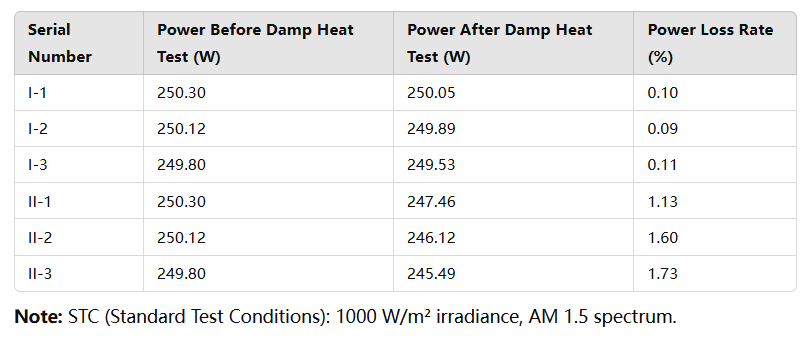Over time, the performance of solar panels gradually decreases, a phenomenon known as degradation. Understanding solar panel degradation is crucial for assessing the long-term benefits and reliability of solar power systems.
Types of Solar Panel Degradation: Initial and Long-Term Degradation
Solar panel degradation can be classified into two types: initial degradation and long-term degradation.

Initial Degradation: This typically occurs within the first few months after the solar panels are installed, and the degradation rate is relatively high. Initial degradation mainly results from unstable factors during manufacturing and the initial operating phase after installation. Generally, the initial degradation rate ranges from 1% to 3%.
For example, if a solar panel has an initial power output of 300 watts, and the degradation rate is 2%, its output could drop to 294 watts.
Long-Term Degradation: After a few years of use, the degradation rate slows down. Long-term degradation is influenced by various factors, including the material quality, manufacturing process, environmental conditions (such as temperature, humidity, and sunlight intensity), and daily maintenance.
Under normal operating conditions, the average annual long-term degradation rate for crystalline silicon solar panels typically ranges from 0.5% to 0.8%. For instance, if a solar panel has an initial power output of 300 watts and a long-term degradation rate of 0.7%, after 10 years, its power output would be approximately 207 watts.
Factors Affecting Solar Panel Degradation
Environmental factors play a significant role in solar panel degradation. Some common factors include:
- High Temperature: High temperatures accelerate solar panel degradation. If solar panels operate in environments that exceed the standard working temperature (usually 25°C), the degradation rate may increase by 0.03% to 0.05% per degree Celsius. For example, if the solar panel operates in an environment of 50°C (a 25°C increase), the degradation rate could rise to approximately 1.45% per year.
- Humidity: In high-humidity environments, moisture may penetrate the solar panel, leading to the aging of encapsulation materials and the corrosion of cells, which can accelerate degradation. In environments with humidity above 80%, the degradation rate may increase by 0.2% to 0.3% annually.
Dust and Dirt: Accumulation of dust and dirt can reduce the amount of sunlight the solar panels receive, leading to a decrease in power output. If the solar panel surface is 20% covered with dust, the output could drop by 30% to 40%.

How to Delay Solar Panel Degradation
To reduce solar panel degradation, the following measures can be taken:
- Regular Cleaning: Ensure that the solar panel surface is free from dust and dirt to maintain its light absorption efficiency.
- Optimize Installation Location: Avoid installing solar panels in high-temperature or high-humidity environments. Choose an appropriate location to minimize environmental factors that contribute to degradation.
Regular Maintenance and Inspection: Periodically check the condition of the solar panels and address any potential degradation issues promptly to maintain the system’s high efficiency.
Conclusion
Solar panel degradation is a complex process influenced by a variety of factors. When designing and installing a solar power system, it is essential to consider these factors thoroughly. Selecting high-quality, reliable solar panels and ensuring regular maintenance and cleaning can slow down the degradation rate, extend the lifespan of the solar panels, and maintain high power output efficiency.
Since 2008, Maysun Solar has been dedicated to producing high-quality photovoltaic modules that contribute to combating climate change. Our advanced technology in IBC, HJT, TOPCon panels, and balcony solar stations ensures exceptional performance and reliability, capable of withstanding harsh weather conditions for long-term operation. We have established offices and warehouses in multiple countries and built lasting partnerships with top installers to provide comprehensive support. For the latest quotes or any inquiries related to photovoltaics, feel free to reach out to us—we’re here to help!

How to Effectively Clean and Intelligently Maintain Photovoltaic Systems for Optimal Performance?
Explore how scientific cleaning and intelligent maintenance can ensure the efficient operation of commercial and industrial photovoltaic systems. Practical advice covers module cleaning frequency, monitoring system configuration, and long-term strategies for energy savings and performance enhancement.

2025 European Photovoltaic Policy Map: Deployment Paths and Regional Strategies for Commercial and Industrial Photovoltaics
A comprehensive analysis of the 2025 European commercial and industrial photovoltaic policy map, focusing on deployment strategies, incentive comparisons, and zero-investment models to support businesses in achieving an efficient and green transition.

Empowering Factories with Solar Energy A Strategic Tool for Controlling Production Electricity Costs
Commercial and industrial solar is becoming a key solution for factories to reduce electricity costs and hedge against price fluctuations. This article systematically analyzes its deployment models, cost advantages, and sustainable value pathways.

How Businesses Can Offset Carbon Taxes with Solar Power
This article analyzes the latest carbon tax policies and photovoltaic deduction strategies, helping European businesses legally reduce taxes, increase profits through solar investment, and achieve a win-win situation for both economy and environment.

Forecast and Response: Seizing the Next Decade’s Growth Dividend in Europe’s Commercial and Industrial Photovoltaics Market
Maysun Solar analyzes the growth trends of commercial and industrial photovoltaics in Europe over the next ten years, from policies and ESG to technological innovation, helping companies seize the initiative in the energy transition.

How to Calculate Solar System ROI and Optimize Long-Term Returns?
Solar power is becoming a key solution for businesses to reduce costs and improve efficiency. Accurately calculating ROI and optimizing long-term returns are essential to maximizing investment value.



